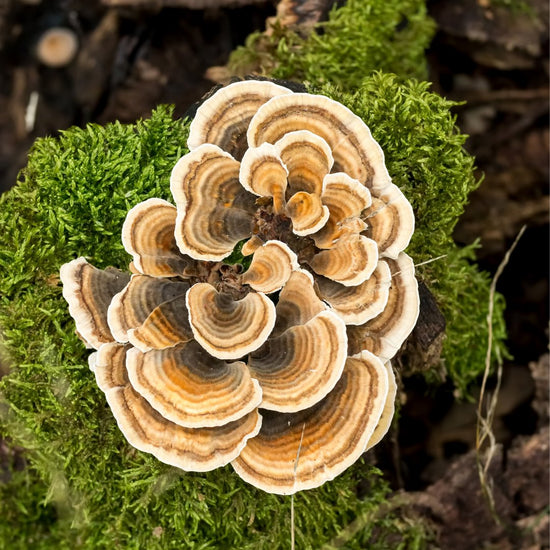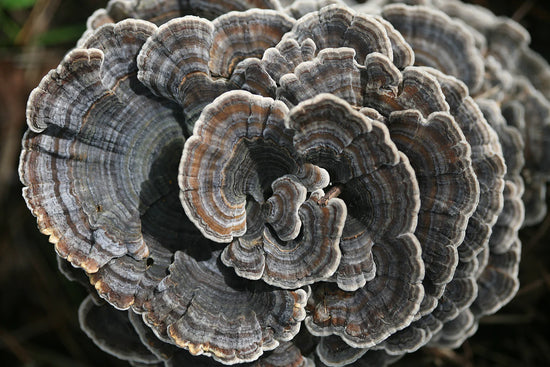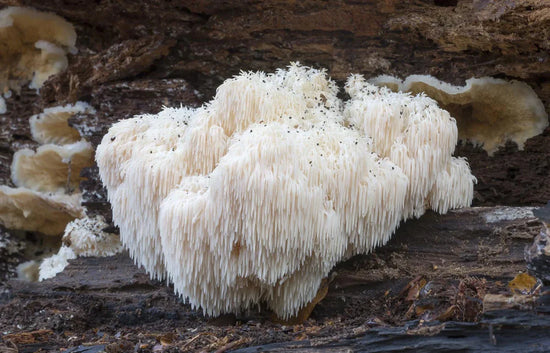Bat Killing Fungus Taking Over with Alyssa Bennett
Alisa Nappa
">
.js?container_id=buzzsprout-player-&player=small"
type="text/javascript"
charset="utf-8">

The white-nose syndrome is a deadly fungus killing bats around the world and is quickly spreading in North America. We sit down with Alyssa Bennett who's dedicated her life to researching this phenomenon and help these endangered bats.

TRANSCRIPT
Alex 0:11 Welcome, welcome. You are listening to the mushroom revival podcast. This is your host Alex Dore. And we are absolutely obsessed with the wonderful, wacky world of fungi and mushrooms, weird guests from all around the world to geek out with us and go down this mysterious world of mushrooms and fungi. Today we have Alyssa Bennett, from Vermont, studying bats and the effects of an interesting fungus on them that turns their noses white. So, Alisa, how you doing today? Unknown Speaker 0:45 I'm doing well. Thanks so much for having me. Alex 0:48 For people who don't know your work, what are you up to? Speaker 2 0:52 I'm a small mammals biologist with the Vermont Fish and Wildlife Department. So I work as a manager at a state agency. And I love it because I get to work for all the people of Vermont on the conservation of wildlife and their habitats. But most of my work actually focuses on our nine that species. Alex 1:13 And the US specifically study, or what we're going to talk about today is this deadly fungal pathogen, which colloquially is called the white nose syndrome. But its Latin name is probably going to butcher this sudo Chai no ascus destructans. Something along those lines. Speaker 2 1:39 Pseudogymnoascus destructans, it originally was identified and named geo my CS distract dance, but then became reclassified once we learn more about it. But it was a fungus that before we saw it killing bats off, people didn't really know this fungus well, and it was identified as belonging to family of soil fungi. So it's not only something that's deadly to bats, but it actually can live in the environment, even without them, which is one of the things that also makes it so difficult for us to try to get rid of, I guess, as a threat to that's Alex 2:16 interesting. Yeah. And how did you originally get into bat conservation and this fungus in particular? Speaker 2 2:25 That's a great question. I have always been fascinated by bats. I remember in college finding one that didn't make it on the ground at my campus and just taking a look and being so interested in the fact that their bodies were so similar to ours, they just have this very thin skin tissue that stretched out between all of their fingers. So if you were a bat, and you thought of your skeleton and how similar it was to bat, if you were to stand up, and you were to imagine, just close your eyes while you're standing, point your fingers towards the ground and imagine that your fingers were so long that they touch the ground while you were standing. That is what about skeleton is like they have these really elongated fingers, and they're flying on those. But that gives them this very thin skin tissue. And I remember thinking they were such incredible creatures. I know I did at least one paper on college on them. But I was told you will never get a job in this field. Because that was back in the 90s. And there were very few people that were bat biologists. But then unfortunately, what happened is this really intense threat came along that caused mass mortality in many of our bat species, specifically those that Hibernate underground. So this is a fungus that was accidentally introduced from Europe. And it's spread like wildfire, like any other kind of invasive might do, and the United States and Canada. And it's now caused 90% or more of that populations to decline for certain species that are really highly affected. And what happens is it actually invades that really thin skin tissue that's on their wings and their tail, and it just eats right through that skin. The fungus and the bats arouse too frequently in the winter, they get very sick, and they burn through all their fat stores that they would need to hibernate. And a lot of them just don't make it through the winter or die in the spring. So it's a really deadly fungus. And it just happened that when I circled back to the world of wildlife after graduate school several years later, there there were jobs in this field now so unfortunately, due to this massive threat, there were jobs working with that and that's how I was able to get into it. Alex 4:42 Do you do we know? As of as of now how this fungus spreads, I'm guessing you know, as you're talking about it, you know, lives on bats but also in the soil. So I'm guessing there's multiple vectors of contamination. In going on and how it spreads, and where it lives, do we know, you know, the different ways in which this fungus spreads? Speaker 2 5:08 Yeah, you're absolutely right there that there are many ways for it to spread. So we know that it can spread from that to that most of these species that are affected are very social. So they roost right next to each other in the summer, but more importantly, in the winter. And because this is a psychrophilic fungus, it's actually really likes these cold damp environments where bats roost, they need the cold so they can drop their body temperatures and conserve energy for the winter. And then they need the moist environments so that they don't dehydrate over the winter. Unfortunately, that's in a temperature range that is just perfect for this fungus to grow. And because these bats will huddle up next to each other, they can spread it to each other, they can spread it to the cave or mine walls, and the fungus can live on that as well on the rocky areas. And then new bats coming in can then pick it up from the walls. So it can go back to that that to site site to that. And then unfortunately, people can accidentally move it because it's actually like some other fungi that people might be aware of that sometimes grow on our bodies even, it can be really difficult to get rid of them. And the spores are very tiny, they can be transported really easily. So if you were to go into just one of these beautiful commercial cave systems where people go as tourists and visit, you could easily get the soil on your boots or shoes, and then unknowingly be transporting this. And usually we have to use something like a boiling water or a 10% bleach solution just to kill off the spores and make sure we don't spread it to a new site. So that does make it easy to transport. Alex 6:48 Is that how we think it spread from Europe originally? That's definitely the theory. Yeah, I think the first cave was in upstate New York, right in the United States? Or is it Vermont's? Correct? Speaker 2 7:00 Yeah, that's correct. It was an upstate upstate New York is the first place that we're aware of this Fundis occurring. And there were some photos that were obtained during just a routine survey where biologists such as myself go underground, and we count the bats by species so that we can monitor their populations under underground over the winter. And what we noticed as a community was this powdery white substance on the nose of some bats, and that had never been observed before. And people did look back at historic photos, and we never seen anything like that. So when it does first arrive at the site, usually within a couple of years, you'll see those spores present. But the fungus can still be there even without that sign, most of the damage actually is on the that thin wing tissue. But that's where it was discovered. And it was part of a cave system that actually has a tourist part to the game cave system. So the going theory is based on the fact that people travel across the ocean, from Europe to the US and Canada much more than then that's due, we don't really we aren't aware of those types of migrations in bats. We think that we probably are responsible for just accidentally transporting it here. Alex 8:18 I feel like that's so rare to humans being responsible for biodiversity destruction. I mean, I just never, never hear. Yeah, it's crazy. Yeah, this must be the first time this has ever happened. Speaker 2 8:32 This sounds like the first ever. Certainly, yeah, a lot of great theories out there about the idea that every now and then you'll find a bat that stowed away on a container ship or something like that, and made it across the ocean. And so people thought, well, maybe that's how it got here. And we probably didn't have anything to do with it. There certainly was a concern that from the organized caving community, people who do that recreationally that they would get blamed somehow for this. And I don't think that we're ever going to trace it back to any individual. And maybe it was introduced a couple of times, there is some evidence for that right at different locations. But I think it's just our awareness that this brings some awareness to that idea that we are a really global species. And we do move around a lot. And certainly, it's easy for us to even totally unknowingly and unintentionally move things around with us. And it's allowed us as biologists to look at some of our other practices and think about how we can be careful even doing things like catching bats. Now we may wear masks, even though the threat of COVID has decreased in a lot of places from human to human. We still have concerns that we could actually be spreading that virus to bats and that they may be vulnerable to that, even though it's there isn't actually any evidence to show that it has gone directly from bats to humans, that that unfortunately has gotten some bad press but but we're concerned We could actually give it to that's Alex 10:03 interesting. Yeah, I, you know, it seems like there's multiple concerns here. Definitely during COVID That was, I saw many articles going around of people being afraid of researchers going into caves and you know, unlocking these mystery viruses that were hidden in caves for a while then spreading it, but it seems like vice versa of of humans giving these bats, different diseases and things like that. So, when you are about to go spelunking, or whatever the word is of going into a new cave and doing this research, are you do you have to wear like a full Tyvek suit? Or, you know, bleach your shoes? Or what is the safety protocol? Beyond wearing a mask and an? Unknown Speaker 11:06 Ope Can you repeat that one for me? I just missed that last question. Alex 11:10 Yeah, um, how how have the safety protocols? What are the current safety protocols for entering a new cave and how they change over time. Speaker 2 11:21 So currently, before we go underground, or before we capture baths and handle them at all, we are thinking about ways that we could spread the fungus so we follow white nose syndrome, decontamination protocols, and there are national protocols in the United States that the US Fish and Wildlife Service helped create, and our Canadian counterparts have their own version as well. And that gives a number of different types of ways that you can kill off the fungus so that you don't spread it from one site to another Tyvek is a great example. We do have cave seats that cave suits that we decontaminate and boots, which we do with a hot water wash a certain temperature for a certain amount of time. And then there are other types of treatments like a 10% bleach or antifungals that we can use. So there are a number of different possibilities, but it's everything from our headlamps to our boots. And also the masks like I mentioned. And then we're also rabies vaccinated before we handle that because we absolutely do take seriously that idea that there are diseases and viruses and things that can go both ways human to that that to human so we try to be careful and respectful. Alex 12:35 So I was reading an article. I think it was a week ago or something about the difference between flying foxes and bats, or, or fruit fruit bats. I didn't know that there's a difference. And you know, we're talking right before we hopped on here and and you said that most people just think bats are bats, you know, and there's not there's all these different kinds. And I thought flying foxes was just kind of like a funny colloquial name for bats in general. Like they kind of look like flying foxes. But apparently it's a it's a type of bat and and so or fruit bat. So I'm just curious on what what type of bats does this fungus in fact, in on what type of bats do you study? And how does this fungus you're, you're saying how it in infects the different species of bats differently. And so what what have you noticed among the bats that you study? Speaker 2 13:42 Yes, so Worldwide, there are over 1300 different species of bats. In fact, it's very diverse group chiroptera, which means handling is the order of species that make up bats. And then want to zoom into where I am in Vermont here, we actually have nine different species. So once we get into kind of this colder northeast climate where I live, we're looking at species that either have to hibernate for the winter, or they have to migrate south for the winter. And these are really small bat species. So from that 1300, you would divide into a group of micro chiroptera and mega chiroptera. And those mega chiroptera are things like fruit bats, flying foxes, those are in warmer parts of the world. But then there are also bats in different parts of the world that are pollinating that that are nectar eating bats that eat frogs or all sorts of other animals. And in Vermont here we have all insect eating bats. So these are bats that are foraging at night and either capturing insects out of the air or gleaning them off of vegetation. But we do have parts of the United States where it does get warmer in the southwest and in the desert where we have that species that even do things like eating scorpions off the ground. So we do have some variety here in the US. But up in Vermont, we have five species of bats that hibernate in the winter and go underground that are really highly affected by whiteness syndrome, and then one that really doesn't seem that affected and is not listed as threatened or endangered. And then we have three others that fly south for the winter and use that as a strategy. So those species are not affected by this fungus, because they're not going into caves and mines where the fungus lives. And that's really when this fungus is doing the damage to bats. Alex 15:40 Right I was reading that P destruction. P destructans. Is a site Psycrow file I think is how you pronounce it fungus which which means you know, it likes colder temperatures between negative four degrees Fahrenheit to 68 degrees Fahrenheit if it you know, I think that there's a range between like 40 and 68 degrees Fahrenheit, which it's mostly 40 A then sometimes it goes up to 68 or something. So it really likes colder environments it likes when bats are hibernating. And so I'm in Texas, in Austin, and we have the largest colony of bats, like probably a half hour away from me and around San Antonio. And we also have another huge colony, right downtown and Austin underneath the bridge. And these are all Mexican freetail bats, but I was which migrate to Mexico, and then and then back, which is probably good as a defense against this fungus, although I looked at some maps of how this white nose syndrome has spread throughout the United States in North America, and it seems like it has reached Texas, which was surprising, because it is hot here. Do Is there much data on the differences and how this fungus operates in colder climates versus warmer climates? Is it just more Versiv? I don't know if that's, that's the right word. Is it? Is it more aggressive in colder areas and then warmer? It's just kind of a rare occurrence or like how does it operate here in Texas, for example? Speaker 2 17:34 Yeah, that's those are such great observations. So you're absolutely right that we consider this kind of as cold loving fungus. But what's interesting is, if you think about where bats are hibernating in Vermont, for example, that's tend to drop down into that hibernation state or what we call bouts of torpor, when it's below 50 degrees. And so they find these places to go underground where the temperature is below 50 degrees, typically, in the middle of the summer or the middle of the winter. So in Vermont, it might be 80 out in the summer, but then it's still 40 to 45 degrees in the cave. But then in the middle of the winter, it's negative 20 outside, and it's still 40 to 45 degrees in the cave. So they tend to look for these stable environments so they can go into to save energy that's below that temperature. And what we thought was, even though bats are hibernating in maybe similar conditions, as you go south, probably slightly warmer on average, in some of those underground sites. We did think, well, the winters are much shorter, even somewhat non existent in places as you go south. So we probably won't see the same effects. And surprisingly, as the, the fungus and the disease spread south and got to locations like Georgia and Alabama, we were shocked to see that it was still having an impact on that there. There hasn't been in some of those southern states like Texas for very long. So we're not really sure what the long term outlook is like there is in Vermont here where we've had it since 2008. And we consider it endemic. So we're still kind of learning but it is a big concern still in the southern states. And they do see some similar trends for a few of these species where they see 90% or more of the bats decline in the sights from the disease. So so we thought there was going to be a big difference, just like you're suggesting, but we didn't see that for a few of the really affected species. And we're still trying to understand why. Because one advantage is that the bats that are able to be more active in the wintertime where it's warmer, can periodically come out if they're rats from the fungus and maybe get something to eat and kind of deal with that loss of fat stores from being aroused too often, and so that does seem to be advantage for some of those species. And then you mentioned Mexican free tailed dots, those absolutely I think that's a great example of a species that we think Probably won't be directly affected by white nose syndrome, because they're not hibernating. So they're not going through that same type of behavior where they're susceptible to the disease. But is there a chance that maybe they could accidentally be spreading it to areas further south? And will that be a concern? We're not yet sure. Because sometimes we do have species that aren't hibernating, that use case in the summer, like, like Mexican free tailed bats, that sometimes are the same sites as another. That might use it a different time of year. So there could be some mixing their species and that's moving stuff around. So we're still learning about that one. Alex 20:45 Yeah, and they might actually benefit from for having more mosquitoes and insects around that are not being eaten anymore. So yeah, we'll see there. I mean, we we had a couple of cold fronts move through where we've had like a freak snowstorm or whatever. And the last one I remember a ton of bats died. And it was it is a really big thing. Seeing everyone was finding them all around the city of Boston. And so yeah, it seems like the cold the cold brings a lot of threats for for a lot of bats. And, yeah, I know this originated in Europe, or our basic understanding, as of right now. And it seems like the bats are in Europe, most from what I read are acclimated to this fungus now and maybe it built up an immunity and have certain genes to fight off this fungus. But here in North America, it's so knew that it's it's a big threat. Is the is the understanding right now that are we hoping that these bats here in North America are going to acclimate and build a natural immunity towards this fungus? Or is there also a concern that this fungus will mutate and become a quote unquote, super strain and, and even cause havoc in Europe? Again? Or kind of what what's what's the general fear fear level of this this fungus in North America? Speaker 2 22:30 Yeah, I think you've actually touched on maybe some of the most interesting parts of the story and, and also some of the big parts of concerns. So the fungus has been found in many European countries, and even as far east as Eastern China when some of my colleagues have sampled out in those locations. And there are different species, obviously there, but some of them are related, they may be in the same genus as our species. But we don't have on record any mass declines. And those are even really evidence that bats still right now or are dying when they're living with the fungus in those sites. And when we look at the phylogeny, so we look at kind of a family tree of fungal samples. So let's say you were to get a sample this fungus from caves in Germany and France, and Austria, and then you were to look at those they're really distantly related. And they're very far apart on the family tree. If you were to take a sample from Vermont, and Texas, and Pennsylvania, you would find that those are near clones of one another, very, very closely, like right on the same branch of the tree. So what that suggesting in and there's other research to back this up is that it is an introducing invasive fungus that was really not something that our species had ever been exposed to before. And that, on the other hand, it's probably been around and evolving for a really long time in Europe and Eastern Asia. And so it's possible that there was a mass mortality event from that species there. Or it's possible that it just naturally co evolved with the bat species there. And just like plants that we see that we consider to be invasive over here that take over, they're not necessarily behaving the same way in the environment, where they've had time to slowly evolve with the other organisms around them. So it's hard to know, since we really haven't been monitoring that populations in most places, really for more than 100 years. It's hard to know what went on. And the idea is that it's possible that this fungus had been evolving for hundreds or hundreds of 1000s of years even over in some of those other locations. So I think the interesting part of the story is that we are seeing evidence for at least one of our species little brown bats here in the Northeast, where the fungus has been for a while. And this is one of our hardest hit species over 90% of Little Brown. ought to have died off in our underground states, and those that are showing signs of what we would call a rapid natural selection. So if you imagine that this was one of the more common species, little brown bats before the disease arrived in the US and Canada, they're pretty widespread. They live in people's attics. So they actually have adapted really well already to loss of natural habitat. And they were doing really well before the disease, and then 90% of them died off. So you go through a population bottleneck. And then what we have seen when we've sampled that's before and after, and worked with some colleagues at Rutgers University, is evidence that there are genes that are being selected for, that are expressing things like hibernation behavior, and immune response. And of course, we have to remember that there's not one gene for one thing, and that isn't really sort of how our DNA works. It's much more complex, and we have many genes being turned on and off and expressing at different times in development and, and throughout in organisms life. And it can be a really complex way than organism deals with some kind of threat like this. But we are seeing differences in the surviving population. And we believe that those are differences that can be passed on to their young. And what I can tell you is we have individuals for that species that we have captured throughout the disease, meaning that we have individuals that we had captured and put a band on before white nose syndrome was here. And many years later, found them still alive, because these are species that live into their 30s. And so it's very exciting for us to think that individuals are surviving, they're passing this information on to their young, and that they could potentially rescue is the idea, the whole population. Alex 27:01 And identifying the the, or quantifying the amount of these bat populations in certain areas is crucial for this research. I was reading one article, I think it was in Virginia or some some state I can't remember. But the article said that the population went down 99.9%. And they said at a certain point, they only had six bats in a mineshaft or some cave somewhere. And I was thinking like, how do you know that? Like, how do you how do you keep track of how many bats are in your state? Twos to a number six, like how do you do they have trackers on it? I know some animal conservation. You know, they capture certain animals, and they put a little tracker on them. I was also reading in one article that you teamed up with a researcher, Laura Clover Klopper. I don't know how to pronounce her last name, but she was using that for you. Yeah, she she was using acoustic modeling. And she's a bio Acoustics expert from University of New Hampshire to measure the baseline of bat populations from a quick Google search of what acoustic modeling is it using? Sound waves, I believe to to measure things. And but I am not sure what this is. And I don't know if you are either. But what are the current methods of tracking population? And how is that acoustic modeling going? Speaker 2 28:47 Yeah, so let's say the things that are easier for us to do are to measure a relative change in population over time. It's harder for us to understand, in some cases, what the total population sizes are the population number, even something you know, in my state, we can much more easily tell you that we have an estimated 5500 black bears here, because we have so much data from hunters harvesting those animals and from sightings out on the landscape so we can get a pretty good sense of the actual number. They're large, they're easy to see with bats. They do tend to hide out of sight a lot of the time in the summer and the winter. We track them in the summer back to roost using things like little tiny radio telemetry equipment that we glue onto their back and can listen with radio receivers. But in the winter, we literally just kind of it's like walking into their house and counting how many are there. So we go into these underground places like caves or mines, all dressed in our suits that we can decontaminate so we don't spread the fungus. And we literally count them and record how many we see of each species. Now for some sites that is that easy if you picture, just one straight line chat where people were digging for some kind of element up here, like, we have some old gold mines, where people who were looking for gold, you could actually see all the cracks and crevices and holes and know exactly how many bats are there from one year to the next. So that's how we knew that for one site, for example, we had 657, little brown bats and maybe 39, or something northern longer bats before the disease. And now we're down to literally handful less than a dozen little brown bats and no northern longer bats left. So the sites you were mentioning were they're down to six bats. That's because they've been going and visiting those same locations that we know about year after year, counting the bats and recording that. And seeing that change, there are likely lots of underground places that bats are going in the winter that we don't happen to know about. So knowing the exact number of bats out there is a lot harder. But it was very easy for us when we went through a process of listing some of these species as threatened or endangered to see a population trend that was really devastating. So when we see the numbers at those known sites come crashing down like that. And for some species, northern longer bats, for example, I have not seen one underground for the last several years in all of our surveys. And so they don't have a rosy picture in the way that I think that little brown bat that I talked about, might be adapting. So it does really vary by species there. But for some of these sites, it's harder because some of them are unsafe, there are really unstable mind sites that have you ever seen the Lord of the Rings. And you imagine going underground when I watched this movie I was before I ever was at that biologist, I had read all the books. And then I watched the the first movie The Lord of the Rings. And I remember in those movies, seeing them go underground to where the dwarves lives. And there is a scene where they're they're walking through this, this mine and it's dark. And Gandalf says let's have some light, and he lights up the room and you see chamber off of chamber off of chamber, it seems like this endless underground space. And I've been to spaces like that there are places that you can drive cars and trucks into their enormous sites that go on for miles underground. So the idea that we will be able to get to all those places. And then there are other sites that are just unstable and unsafe rock, and we have one in particular, that is a cave, that unfortunately has just passed the main entrance hall, it has an area that is really not that safe for people to go into. And that leads to the whole rest of the underground site. So it's not a place that we can safely count that teach here. And yet, the majority of little brown bats in the entire New England area, and likely other parts of the Northeast, like New York, Hibernate at this one site. So it's absolutely critical for the species survival, to have the site when we have 10s of 1000s of bats there. And yet, I can't go in very far to actually count them. So that's where Laura's research came along. And Laura Klepper is really an expert in this area of bio acoustics. So she's looking at a way of using the sound energy that she measures by putting devices into that entrance hall when we see that coming out in the spring, and measuring that energy level, and using that as a proxy for the population size. So if we measure the amount of energy over a period of time, over several days, from one year to the next, can we look at that same type of question of relative change, and also potentially use that to come up with an actual population? So it's something I'm still learning about, but it's a fascinating field. Alex 33:58 I mean, it's almost like biomimicry, we're, we're pretty much using sonar technology to to measure how many baths there are. Which is pretty cool. It's it's pretty cool to use kind of their superpower to be able to help them. So yeah, that's, that's awesome research. And I'm curious about the potential solutions. bio control is always a very interesting topic. And there's very few instances where humans get it, right. Because, you know, systems are so intricate, and complex with nature and the littlest things can throw off whole ecosystems and when we try to introduce another species to kill off another species, you know, there's countless instances of us making the problem worse, and so I was reading about, you know, A few different potential solutions. You know, let's let's start with one that you briefly mentioned, which is, you know, dipping your boots and antifungal agent. I was, I was doing research on, we have a couple of dozen antifungal solutions that, you know, when I was reading it sounds like they have long chemical names. And you know, I, I? Well, let's so let's start there, I'm guessing, maybe they haven't been used or maybe the they are being used, but I'm worried that they might cause ill effects on the bats as well. Is that the case? Speaker 2 35:43 That's absolutely a concern. So we sometimes call those non target effects. So let's say what you wanted to do was go into the cave or mine where bats hibernate, and kill off just this fungus. But then the concern is those non target effects. So what if we're killing off other things in the environment that we actually want there. And so this goes through, if you have something that you're interested in using, it goes through a whole careful process. So a lot of our research collaborators that are at larger colleges and universities will find different types of agents and start that process in the lab to see if you grow Pseudogymnoascus, destructans, or PD, the cause of white nose in a petri dish, and then you put one of these other agents in there? Does it kill it off? And then the next step would be, you take a sample of all of the things in the microbiome on a backswing and put that in a petri dish and see what else does it kill off, and you get a sample of the soil or the things that are on the cave walls and find out what's living in there that might get impacted. So we are always looking at those those types of things. And that's why people have been investigating rather than using bleach to kill off all of the fungus in the cave, they've been looking at what we like to call bio controls. So other natural things. And in some cases, that means literally, that people have been looking at what other natural things already occur in that environment. That may be either detrimental to PD, or just kind of slow down its growth or out competed or something like that. So those are bacteria, other fungi, or other types of things in the environment, including things like so what I'm looking for probiotics is another one that's been tried. So what people started doing research started, researchers started doing was actually looking at species that were doing well. So the big brown bat is not as highly affected. Even in the lab, you can smear a sample the fungus on their wings, and they barely even not an immune response, they just don't seem to get really sick. So then my colleagues were looking at, well, what's on their wing tissue, and they have a different microbiome than some of these affected species. So they were actually then taking things that are on the wing tissue growing on the wing tissue of bats, they're doing well, and developing those as agents and bio controls that we could potentially use. So there are, as you mentioned, a number of different things that people have been running through trials, which has gone from the lab, to that tissue in the lab to bats that are in captivity. And now finally, some of them that appear to have very little as any nontarget effects and break down pretty immediately in the environment are the ones that are showing promise and are being actually tried in the field now. Alex 38:50 That's awesome. Which is interesting, because there's a study published in the Journal of nature in 2018 that discovered that PD the fungus lacks and ability to repair DNA, which has been damaged by ultraviolet light. And so some researchers were proposing the idea of installing UV lights at the entrance and exits of these caves. So the bats would fly through and it would kill the fungus but it sounds like that might not be a good idea because it would simultaneously kill the probiotics on the wings, which are doing an amazing thing for this immunity, which is, you know, kind of a larger discussion on antibiotics versus probiotics and so yeah, I'm excited for for probiotics and and using things that are already naturally there. And you know, we have, I think five more minutes or less so maybe speed round in the last couple questions here. What has been the most challenging part of this research so far, Speaker 2 40:07 I would say is seeing the mass mortality and feeling really helpless about stopping it. So even with all those great ideas out there, we still are really carefully thinking about how some things like a vaccine, for example, might be great for bats out on the leading edge of where this disease is just arriving before it's killed off 90% of the bats, but might not be appropriate here in Vermont, where some of these bats maybe are making it on our own. So figuring out what to do where is very challenging, and then feeling like you are literally racing against time, before 90% of the bats die in a new location is one of the most difficult things. Alex 40:52 Thank you for doing this work. It's not just bats, it's really biodiversity everywhere. So researchers taking a stand and helping preserve our most vulnerable species on this planet is is is really important work. So thank you for doing that. And and that being said, what is the most rewarding aspect of this work for you in which helps the the grief of of seeing this mass destruction. Speaker 2 41:25 Obviously, it's really cool to work with wildlife, I gotta be honest. But I also have to be honest, that that's what I thought would be the most rewarding. And in reality, it is working with the people. It's working with researchers and managers, and homeowners who have pets in their attics. It's working with people that actually care, I literally will get a phone call from someone who says, I have bats in my attic. I can't stand them. They're ugly and disgusting. And I'm terrified. And I'm sleeping in a hotel and I want to sell my house people said all those things to me when bats are in their house. And then there's this pause. And they say, but I know they're in trouble. And I don't want to hurt them. And that is phenomenal to me, that people despite really not liking something or wanting something can still actually care at that level and do something about it. And I think the most rewarding thing here is that people really can make a difference. And I'm seeing that every day here where we have bats that are surviving, because they rely on people. They're living in trees in people's backyards, and people are listening in, they're not cutting down the dead trees in their backyards to make it look like a park, they're leaving those ugly trees there because they've got cavities and peeling bark that bats need to roost in. Because people have bats in their attic. And instead of killing them all with Wasp spray, they're actually very carefully evicting them at the right time of year and putting up a bat house so that the bats are maybe losing access to the ACT attic, which is understandable, but moving into another place that they can live successfully and not being hurt in the process. And we're seeing some of those populations increase as a result. So I personally would say that we are actually seeing conservation working. And we're seeing that for some of these species, because people are making such good compassionate decisions, despite all of the other things that they may not want to deal with. Alex 43:35 If you had unlimited funds, an unlimited team, what research would you want to see done in this field? Speaker 2 43:43 I actually although this disease is such a huge threat. I think one of the other biggest threats to that still is people. Because we have some of these species and more and more bats that really have adapted to living so closely to people as their natural habitat has disappeared. It means that we have that's often in the hundreds living in something like someone's attic or barn. And in that way, they become really reliant on people for their well being over the long term. And yet surprisingly, we know really little about what the success is of them using bat houses or what the perfect design is for a bat house or if we kick them out of the attic in the fall and they come back the next year. You know what happens when that that habitat is gone? So I think learning more about this would allow us to live more successfully with wildlife that's adapting to its changing environment because of us, and living in harmony with them with a lot less conflict. So I feel like there could be a lot more research done there and it would be really fun. Interesting to track those bats around. Alex 44:54 And lastly, where can people follow along? Do you have a website Twitter Are ResearchGate where what's the most useful? Speaker 2 45:04 I wish I was back cool? Yeah, unfortunately the the day to day work keeps me pretty busy. But our our department website, the T Fish and Wildlife spelled out.com is where you can find more about bats and white nose syndrome.org. And that's all spelled out is where you can find out about the work I do at the national level as part of the white nose syndrome response. So those are probably two good sites to go to. Alex 45:36 Amazing. Well, thank you for coming on the show. And thank you for all of our listeners from around the world for tuning in and tuning in for another episode. We don't have a Patreon or any way that you can donate but we do have a website mushroom revival.com We have a bunch of functional mushroom products from gummies and tinctures and capsules. So check them out there we have a bunch of blogs as well free ebooks where people can geek out about mushrooms and if you want to join our giveaway, we're giving away one free mushroom product. So link is in the bio check it out. Tell your friends leave a review and as always, much love and may this force be with you? Unknown Speaker 46:17 Clients Transcribed by https://otter.ai




























